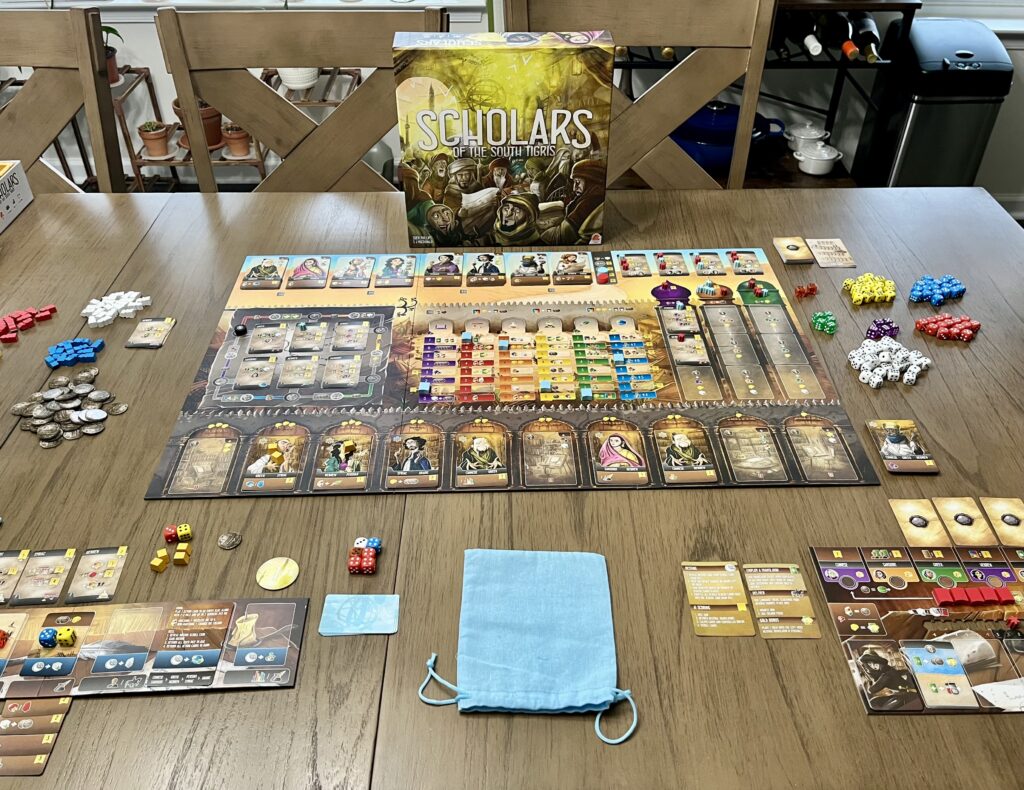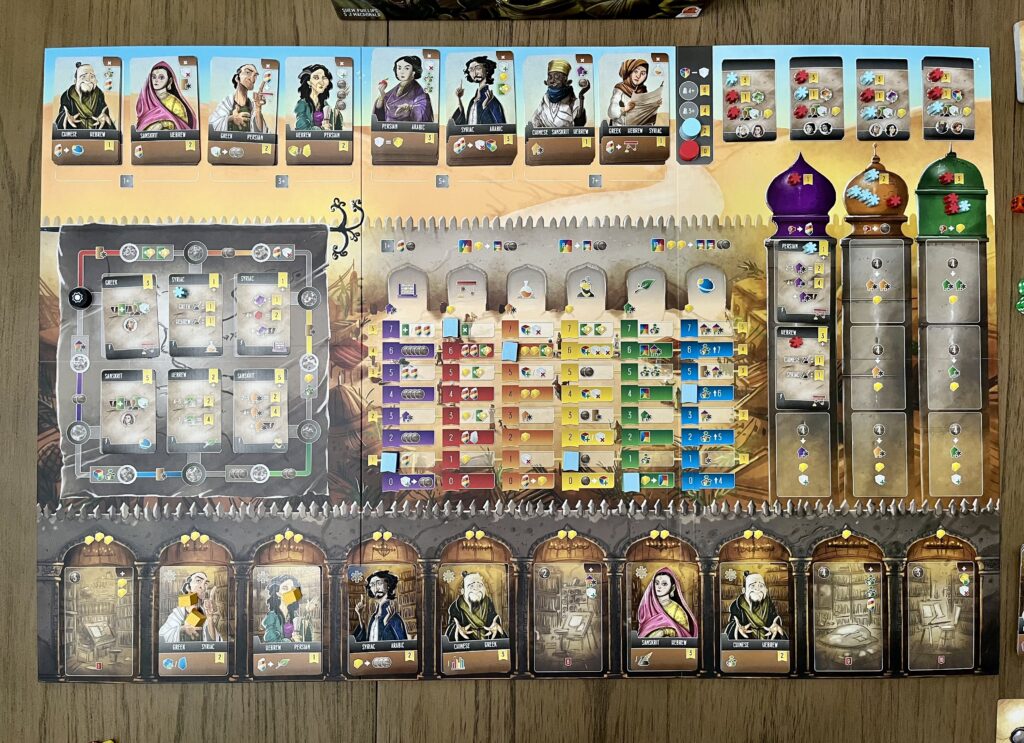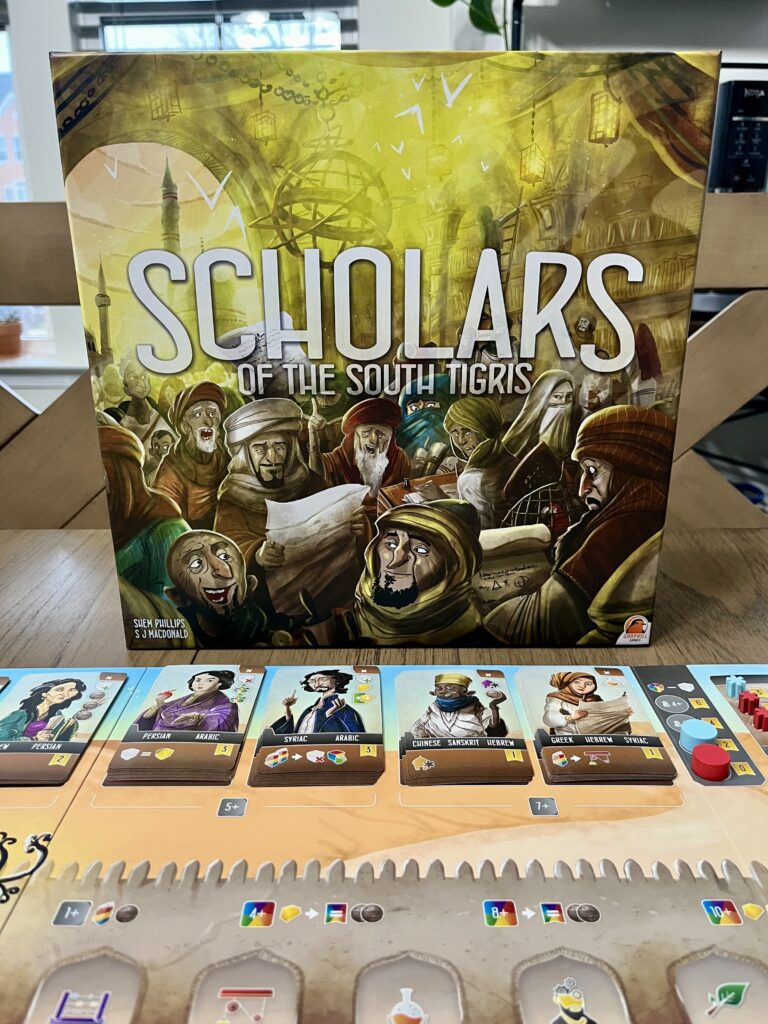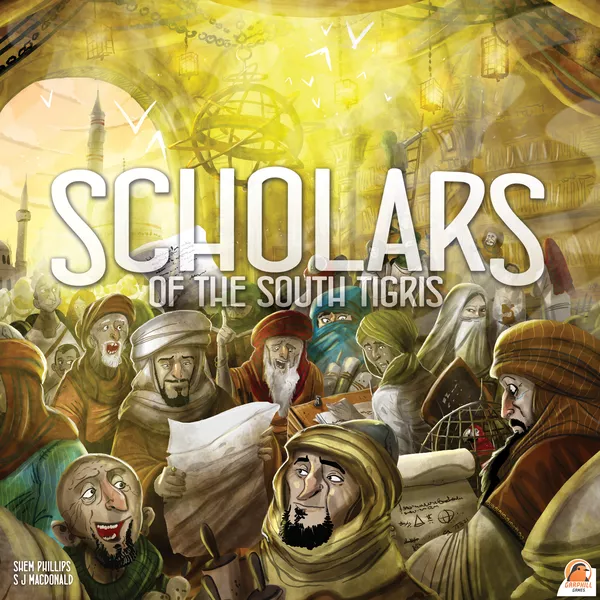Welcome to this week’s review! This week I’m discussing the second game in the South Tigris trilogy from Garphill Games and one I recently did an unboxing for here. So without further ado, let’s jump into my thoughts.
Disclosure: A review copy of this game was provided to The Meeple Digest in exchange for an honest, unbiased review. This review is not intended to be an endorsement.
Scholars of the South Tigris
- Designers: S J Macdonald, Shem Phillips
- Publisher: Garphill Games
- Complexity: Heavy
- Time: 60-90 Minutes
- Players: 1-4
- Main Mechanisms: Dice/Worker Placement
Scholars of the South Tigris is the second game in the South Tigris trilogy from Garphill Games. I’ve previously discussed Wayfarers of the South Tigris here, and it was also one of my favorite games I discovered last year. While Scholars and Wayfarers are mechanically very different, both games utilize dice and worker placement mechanisms.

In Scholars, your main goal is to translate scrolls, which come in one of six different ancient languages, into Arabic. To do so, players will hire translators, deliver scroll cards to the House of Wisdom where they can then be translated, and progress up six different research tracks. In order to carry out one of the four different main actions, players will use a combination of dice and workers.
What’s innovative in Scholars is that depending on the different actions, sometimes only the value of the dice matters, the color, or both the value and color. Dice and/or workers of primary colors (red, yellow, and blue) can be combined to create secondary colors (orange, green, and purple). In addition, when using both a worker and a dice of the same color, the value of that dice is changed to a value of six.
This color wheel mechanism, combined with how the different actions use the value and color in different ways, creates a very satisfying puzzle to solve. While rolling high numbers will ultimately give you more freedom, since not all actions require a high number value on the dice, it helps alleviate some of the luck aspect from rolling dice. For example, when translating scrolls, you are only concerned with making the secondary color corresponding to where the scroll is located, which still allows you to get value out of your low numbered dice.
I mentioned that most of the actions players will take are in pursuit of translating scrolls, which is where players will score the majority of their points at the end of the game. Scrolls will provide a base number of points along with scoring points that meet certain other conditions. For example, a scroll card could be worth an extra one point for every Persian scroll card they’ve translated throughout the game.
I’m happy to report that this theme of translating scrolls really shines through. Scrolls come in one of six different languages that are broken up into three tiers. Some languages, like Persian and Syriac are fairly easy to translate into Arabic and often only require one translator. However, other languages like Chinese and Sanskrit require you to chain multiple translators together in order to forge a path to Arabic. To do so, translators can speak either two to three languages. For example, if I wanted to translate a Chinese scroll, I might have to use a translator that speaks both Chinese and Greek, another which speaks Greek and Persian, and finally one that speaks Persian and Arabic in order to translate that one Chinese scroll into Arabic.
What’s also interesting is that while players can always use the translators they hire, they can also use translators hired by other players, they just have to pay that player one coin to do so. This creates some interesting player interaction, and while you’ll always want to use your translators first if you’re able, you can also use other player’s translators to fill in gaps. For example, in the previous example of translating a Chinese scroll, instead of needing to hire all three of translators, I could instead use other player’s translators to do so at the cost of one coin each.
Another interesting mechanism is what happens when players rest. Whereas in some other games, resting can feel like a wasted turn, in Scholars, resting creates opportunities for players to gain a ton of stuff. When players carry out their main action, they will do so by playing a card from their hand onto their player board to carry out the associated action on their board. Each card a player uses also has rest ability on it as well that they carry out when they rest, usually gaining income from one of the six different research tracks. Therefore, provided the player has played a few cards before resting, resting actions are sometimes the most fun because they get to trigger the rest abilities from all the cards they played and gain income. Tying rest ability to the cards also adds another element of strategy and decision making in deciding which cards to play and in what order, since rest income will be carried out from left to right on the player board.
The game also comes with two modes, a casual and an epic mode. The only difference between the two is that the casual game removes a few scroll cards from the game, which acts as the timer for the end of the game. While each mode plays out the same, the casual version does lead to slightly shorter game, which the rules suggest using with first time players. While I’ll usually opt to play the epic version when playing with experienced players because I feel that this mode allows players to build out their engines a bit more and collect a few more scroll cards, I appreciate both options. I’ll also likely opt for the casual version each time I teach the game.
Finally, the solo mode in Scholars is especially well done, while still being easy to operate. The solo mode involves piloting an AI that comes with a small deck of cards. For the AI’s turn, all you do is flip over the next card and either resolve the top or bottom action depending on certain conditions. The AI board also comes with a rondel that you move their marker around that determines which language, translator, and color the AI will focus on in that moment. In addition, there are also four different difficulty levels, as well as two solo reference cards that explain how the AI will resolve different actions. Overall, I found that solo mode did a great job of simulating a multiplayer experience, while still being easy to pilot.

In terms of weight and complexity, Scholars is similar to Wayfarers in that regard. However, I might give the slight edge to Scholars because it has a few more mechanisms to juggle. One thing to note is that while the actions themselves are fairly straightforward, and players who have experienced other Garphill Games will pick up on some of similar mechanics and iconography, like Wayfarers, this is still a heavy and complex beast. Scholars also requires a fair amount of forward planning. Players won’t be required to plan out their entire game from the very beginning, but since translating scrolls requires a fair number of steps, such as hiring the appropriate translators and delivering scroll cards to the House of Wisdom, players will need to plan out their actions in advance. Also, since resources are fairly tight to come by, I can’t tell you how many times I’ve reached the last step in my plan, only to find that I’m one coin or gold short.
While there are a fair number of ways to mitigate dice luck, there is still an element of luck involved. I played one game of Scholars with my wife who kept rolling low numbers. While players can always use workers to modify the number on their dice, if one player has to use workers while the other doesn’t, it can lead to some frustration. Overall, since you do roll a fair number of dice during the game, and not every action requires high numbers, I didn’t find this element of luck to be too bothersome, but it’s still something to note.
In terms of the different actions, I do really enjoy the puzzle of figuring out which scrolls to target and hiring the right translators to do so; however, I found the travel action to be the least exciting of the four main actions. Taking the travel action involves moving your player token around a rondel of actions. The value of the dice used corresponds to the maximum number of spaces you can travel, and if you use a colored dice matching a line you cross, you get that benefit (coins or influencing a card). When you land on an action space, the spot will either allow you to gain resources, such as coins or gold, or deliver the associated scroll card to the House of Wisdom. More often, players will be using the deliver action to send scroll cards, which is necessary before the scroll can be translated. To deliver a scroll card, players will have to spend coins, and in return, they’ll receive gold, move up one of the research tracks corresponding to scroll card, and influence in the associated guild. While there’s nothing necessarily wrong with this mechanism, I just found it to be less exciting the other elements in the game.
Finally, while the actions themselves are fairly straightforward, I do wish there were some additional player aids or reminders of certain rules. For example, the first time I played, I kept forgetting that when you deliver or translate a scroll card, you get to move up the associated research track. There’s also a rule that when you rest, you draw the bottom scroll card from the stack and there’s certain rules around what happens to that scroll card that you need to remember. Furthermore, while the iconography guide at the back of the rules is nice, I wish the color wheel had been printed on the individual player cards for easier reference.

Overall, I have really enjoyed my plays of Scholars of the South Tigris. The use of colors and dice is very innovative, and there isn’t another game in the collection that provides a similar feeling. Add in the theme and mechanism of translating the scrolls and this game manages to carve out its own place when compared to Wayfarers. I still need to play Inventors, as well as revisit Wayfarers, before reaching a definitive conclusion of where each game ranks; but so far, I’m very pleased with what Scholars brings to the table.
With that, I’ll wrap up this week’s review! I’d love to hear your thoughts on any of the games I’ve mentioned or future content suggestions in the comments below. Happy gaming!
If you liked this post and want to be notified when new content is released, then follow me on Instagram @themeepledigest.
